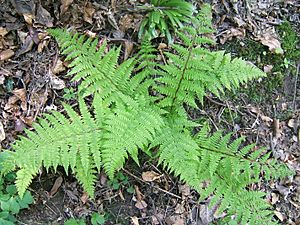Lady-fern facts for kids
Quick facts for kids Lady-fern |
|
|---|---|
 |
|
| Athyrium filix-femina | |
| Scientific classification |
|
| Kingdom: | Plantae |
| Clade: | Tracheophytes |
| Class: | Polypodiopsida |
| Order: | Polypodiales |
| Suborder: | Aspleniineae |
| Family: | Athyriaceae |
| Genus: | Athyrium Roth |
Athyrium is a group of about 180 different kinds of ferns. These ferns are often called lady-ferns. You can find them growing on land in many places all around the world. They are part of the plant family called Athyriaceae, which is a type of Polypodiales fern.
The name Athyrium comes from two Greek words. "A-" means 'without', and "thyreos" means 'shield'. This name describes a small part of the fern called an indusium. The indusium is a tiny cover over the fern's spores, and in Athyrium ferns, it's not very easy to see. The common name "lady fern" usually refers to a specific type of fern, the Athyrium filix-femina.
Some types of Lepidoptera (which are butterflies and moths) use Athyrium plants for food. Their young, called larvae (or caterpillars), eat these ferns. Examples include the small angle shades moth.
What are Lady Ferns?
Lady ferns are known for their delicate, lacy leaves. They often grow in shady, moist places like forests. These ferns are popular in gardens because they are pretty and can grow in many different climates.
Types of Lady Ferns
There are many different kinds of lady ferns. Scientists have identified about 180 species! Here are just a few examples:
- Athyrium filix-femina (the common lady fern)
- Athyrium niponicum (Japanese painted fern)
- Athyrium distentifolium (alpine lady fern)
- Athyrium goeringianum
- Athyrium otophorum
See also
 In Spanish: Athyrium para niños
In Spanish: Athyrium para niños


